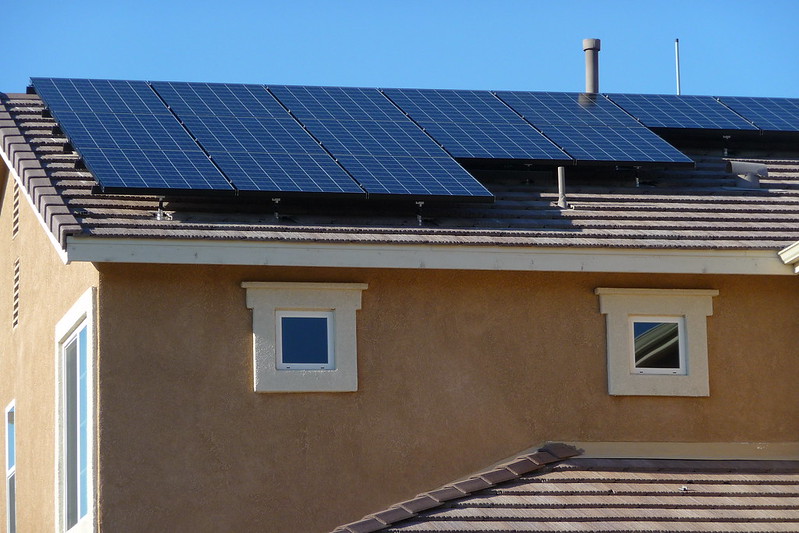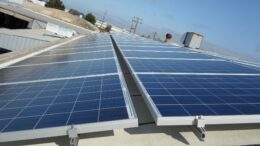Rooftop solar has long been the preserve of the affluent. Solar adopters skew white and wealthy compared to the broader public, according to a report from Lawrence Berkeley National Laboratory.
The number of households installing solar across the country could be much higher, but millions of low-income homeowners don’t have enough capital to pay the upfront costs. While the price tag varies depending on location, incentives, and the type of solar panels, a typical 7-kilowatt rooftop solar system can cost between $17,400 and $24,000.
It can take many years to break even on that hefty investment, but since panels typically last for at least two decades and their costs are falling rapidly, homeowners can save thousands of dollars on their energy bills — if they can find that initial capital.
For those who can’t, there are some emerging alternatives. A growing movement of solar cooperatives is helping low-income households access those financial benefits, while decarbonizing the power sector.
Solar co-ops are groups of property owners who band together to build small solar projects for their communities. “It’s like putting panels on your own roof, except you put them somewhere else with a bunch of other people,” Dan Orzech, general manager at the Oregon Clean Power Cooperative, tells The Revelator.
Once installed, the electricity produced by the panels is injected into the grid and utilities pay for that power using a system called “net metering” that allows co-op members to slash their energy bills. Solar co-ops members own the solar arrays and can therefore take full advantage of federal and state incentives.
Building a solar co-op can be a daunting process that is often facilitated by organizations like Orzech’s and others including Co-op Power and the People’s Solar Energy Fund, to name a few.
One of the largest solar co-op organizers is Solar United Neighbors, which has helped 8,400 people across the United States install over 70 megawatts of solar capacity since 2007.
Solar doesn’t just come in handy during storms! We’ve seen how power can go out during extreme heatwaves, which is why a reliable resource like solar is especially important in hotter parts of the country! https://t.co/OMFhZODshK
— Solar United Neighbors (@SolarNeighbors) August 3, 2023
The nonprofit is seeing increased interest in solar co-ops because people want to lower their energy bills and “they’re concerned about the climate and the legacy they’re going to leave to their children and grandchildren,” says communications director Ben Delman.
But that’s not all. “Some people are also worried about the micro impacts of climate change, like what happens when a hurricane hits and the power goes out,” he says. “We’re seeing a lot of interest in Florida, because you can pair solar with batteries and keep the lights going when there is a blackout.”
Different Approaches
Solar co-op organizers follow different models, but they typically get a few dozen families together and help them negotiate a contract with solar installers that often offer bulk discounts. They also advise them on federal tax credits, as well as state and county-level solar incentives, and help them secure loans, grants, and other forms of funding from local governments and investors.
They also try to ensure that low- and middle-income families can gain access to solar energy. To that end, Cooperative Energy Futures in Minnesota doesn’t require credit checks or income verification “because that’s a barrier preventing a lot of low-income households to participate,” says Timothy DenHerder-Thomas, the organization’s general manager.
Their approach seems to be working: Between 38% and 50% of the approximately 700 people who subscribe to their solar projects are economically disadvantaged.
“Paying $25 or $30 less in your energy bill every month may not sound like much, but it’s money that you can use for groceries or medications,” he says. “It helps people who are struggling to make ends meet.”
The benefits spill over to nonmembers, too. For example, Cooperative Energy Futures tries to hire minority-owned companies to install solar panels. “There are also subcontractors and workforce development partners who are providing employment for Black and Brown workers,” DenHerder-Thomas adds.
Oregon Clean Power Cooperative follows a different approach based on community-based stock offerings that typically allow people who “want to see their money do something positive for the community” to invest around $7,000, Orzech says. The organization combines these investments with grants, tax credits, and donations to finance community solar and co-ops. Community solar projects are small solar farms owned by a third party and tend to offer fewer economic benefits but be ideal for renters.
The cooperative is now working on a solar project consisting of a 75 kW solar and battery system that will cut the power costs of low-income groups in the city of Talent, which was partially destroyed by the 2020 Almeda wildfire.
“This will allow them to lower their power bills by between 50% and 75%, but they will also be having some, albeit small, positive impact on the planet as a whole,” says Orzech. “I think it really gives people a new sense of power.”
The organization has also helped churches, libraries, schools, and at least one farm finance and develop solar projects. Its Oregon Shakespeare Festival Community Solar project was selected as a Sunny Awards winner by the U.S. Department of Energy for its efforts to increase access to clean energy among disadvantaged communities.
Ultimately solar co-ops could potentially help lower electricity prices for everyone because they tend to be in urban areas and don’t require expensive transmission infrastructure to distribute their power, says Crystal Huang, the cofounder of Oakland-based People Power Solar Cooperative.
The organization argues that the current system, under which utilities produce power and distribute it to households hundreds of miles away for a fee, is “inefficient, overpriced and unreliable” and has a huge environmental impact.
Instead, the People Power Solar Cooperative envisions using solar co-ops to create a not-for-profit decentralized energy system.
“Our relationship with energy doesn’t have to be just as consumers,” says Huang. “We can be part of cooperatives that own the energy and completely redesign what the energy system looks like.”
Boosting Efforts
Stakeholders say demand for solar co-ops is increasing rapidly, in large part thanks to efforts by the Biden administration to boost community solar generation from 3 gigawatts in 2020 to 20 gigawatts in 2025 and provide clean energy to five million families. This goal is part of the Justice40 Initiative, which seeks to ensure that disadvantaged communities receive 40% of the overall benefits of climate and clean energy investments.

In addition, the Inflation Reduction Act passed last year provides community solar projects with a 30% tax credit and bonus benefits for projects based in low-income communities or Tribal lands.
“The Inflation Reduction Act is a game changer for solar in the United States,” says Orzech. “Before we had to find tax equity investors and sign Power Purchase Agreements. The same model that large solar investors were using but downsized to a community level. It was a lot of work, but this legislation makes it simpler to leverage tax benefits for community solar.”
Growing Threats
States like New York, Massachusetts, Minnesota and Illinois are also helping solar co-ops, thanks to net-metering rules that pay a fair price for surplus power generated by solar projects that gets put back into the grid, stakeholders say.
“You basically get a one-to-one credit. The value of one electron is equal to what utilities compensate producers for,” says Delman. “But some utilities are essentially monopolies. They don’t like competition from rooftop solar.”
That’s what’s happening in California, where investor-owned utilities recently lowered the price they pay for the solar power that residential solar projects inject into the grid by around 75% and introduced a monthly charge for rooftop solar owners. The discounted rate will only apply to future projects.
The changes effectively slash the incentives that drive solar growth and will likely put solar power out of reach for low-income people in the Golden State, Huang says.
“Utilities are stopping community solar, or local solar as a whole, because it threatens their very lucrative business model. It threatens their existence,” she says.
California isn’t alone. Scores of other states are reviewing their net-metering policies or adding charges and fees that effectively undermine the economic benefits of residential solar, and by extension solar co-ops.
The Carolinas, Indiana, Michigan, Arizona, Utah, and Louisiana have implemented these types of policies, while Arkansas, Idaho, Virginia, and Washington state are considering similar measures, says Autumn Proudlove, associate director for policy and markets at the North Carolina Clean Energy Technology Center.
“I think ultimately residential solar isn’t going to stop growing, especially with these incentives from the federal government, but these state policies are eroding the value to customers in the compensation that they receive,” she says. “It makes solar less accessible for low-income communities because it’s not as valuable under these new structures unless you add battery storage to your system.”
Luckily the costs of battery storage are also decreasing, thanks in part to tax benefits in the Inflation Reduction Act, while states such as Illinois, New Hampshire, and Maryland offer additional incentives.
As a result, residents and co-ops are both more likely to install batteries to use all the power produced by their panels, instead of injecting it into the grid at a discount.
“That’s my prediction,” says Orzech. “But let’s see what happens.”
Previously in The Revelator:
![]()


